
Huntington is a city in Cabell and Wayne counties in the U.S. state of West Virginia. The county seat of Cabell County, the city is located at the confluence of the Ohio and Guyandotte rivers. Huntington is the second-largest city in West Virginia, with a population of 46,842 as of the 2020 census. Its metro area, the Huntington–Ashland metropolitan area, is the largest in West Virginia, spanning seven counties across three states and having a population of 376,155 at the 2020 census.

Huntington is home to eleven parks located in the neighborhoods of Huntington. An amusement park is also adjacent to the city.
Guyandotte is a historic neighborhood in the city of Huntington, West Virginia, that previously existed as a separate town before annexation was completed by the latter. The neighborhood is home to many historic properties, and was first settled by natives of France at the end of the eighteenth century. Guyandotte was already a thriving town when the state of West Virginia was formed from part of Virginia. Located at the confluence of the Guyandotte River and the Ohio River, it was already a regional trade center with several industries of its own when the Chesapeake and Ohio Railway (C&O) reached its western terminus nearby just across the Guyandotte River in 1873. This event was soon followed by the formation and quick development of the present city of Huntington which was named in honor of the C&O Railway's founder and then principal owner Collis P. Huntington.

This is a list of the National Register of Historic Places listings in Cabell County, West Virginia.

The United States Post Office and Court House in Huntington, West Virginia is a federal building housing the United States District Court for the Southern District of West Virginia. It was built in 1907 and expanded in 1907, and again in 1937. The original construction was the result of the Tarsney Act of 1893. The federal courthouse is part of a group of significant civic structures in the center of Huntington that includes the Cabell County Courthouse, the Huntington City Hall and the Carnegie Public Library. The original design was by Parker and Thomas of Boston and Baltimore. The post office has since been moved to another location. In 1980, the United States Congress passed legislation renaming the building the Sidney L. Christie Federal Building, in honor of District Court judge Sidney Lee Christie.

Norwichtown is a historic neighborhood in the city of Norwich, Connecticut. It is generally the area immediately north of the Yantic River between I-395 and Route 169.

The Bean Hill Historic District is a historic district in Norwich, Connecticut that was listed on the National Register of Historic Places in 1982. It consists of a well-preserved collection of buildings focused on the Bean Hill Green, which capture the 19th-century period when Bean Hill was a local center for manufacturing and commercial activity. The district is located in the vicinity of West Town Street between I-395 and Connecticut Avenue, and also extends northeast along Huntington Avenue to include properties further beyond Bean Hill Plain. The district is about 22 acres (8.9 ha) in size, with 23 contributing buildings.
Levi Johnson Dean (1878-1951) was a West Virginia-based architect.
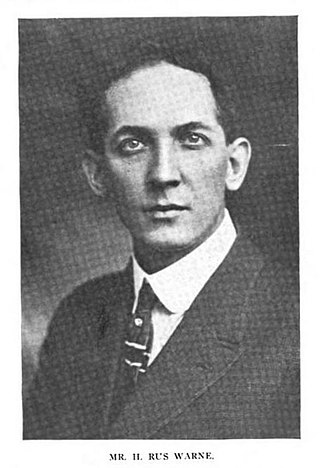
Harry Rus Warne was a Charleston, West Virginia-based architect.
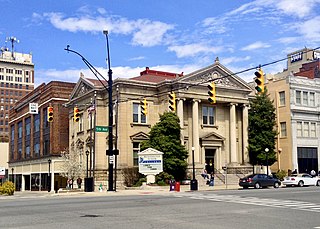
Carnegie Public Library, also known as Cabell County Public Library, is a historic library building located at Huntington, Cabell County, West Virginia. It was built in 1902–1903, in the Beaux-Arts style. It is two stories with a raised basement and has smooth gray ashlar walls. It features a pedimented, central front pavilion with paired Ionic order columns on its portico. The interior was renovated in the 1930s. It is one of 3,000 such libraries constructed between 1885 and 1919. Andrew Carnegie provided $35,000 toward the construction of the Huntington library. It served the community as a library until 1980, when a new library opened across the street. The building houses Huntington Junior College.

The Memorial Arch is a historic memorial arch located in Memorial Park at Huntington, Cabell County, West Virginia. It was built between 1924 and 1929 by the Cabell County War Memorial Association as a memorial to the dead and to those who served the county in World War I. It is built of gray Indiana limestone on a gray granite base. It measures 42 feet high, 34 feet wide, and 9 feet deep. It features Classical Revival style bas-relief carvings. The structure was rededicated in 1980. It is the only triumphal style arch in West Virginia.

Downtown Huntington Historic District is a national historic district located at Huntington, Cabell County, West Virginia. The original district encompassed 59 contributing buildings; the boundary increase added 53 more contributing buildings. It includes the central business district of Huntington, and includes several of its municipal and governmental buildings. It contains the majority of the historic concentration of downtown commercial buildings. Notable buildings include the Huntington City Hall, Johnson Memorial Church (c.1886/1912/1935), Trinity Episcopal Church (1882), Davis Opera House, Love Hardware Building, Reuschleins Jewelry building (1923), the Newcomb Building, the Morrison Building (1919), Keith-Albee Theater (1928), West Virginia Building, and Gideon Building. Located in the district are the separately listed Carnegie Public Library, Cabell County Courthouse, U.S. Post Office and Court House, and Campbell-Hicks House.
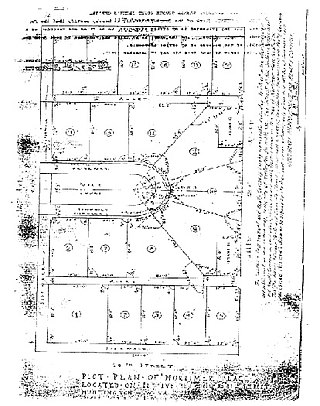
Mortimer Place Historic District is a national historic district located at Huntington, Cabell County, West Virginia. The district encompasses 21 contributing buildings and 1 contributing structure. The district is composed entirely of early 20th century residences, the majority of which are Colonial Revival and Tudor Revivalstyle. They were built between about 1915 and 1930, and feature sloping roofs, parapet walls, and wooden brackets and moldings. The residential development was designed and built by architect Richard Mortimer Bates, Jr. The Mortimer Place Historic District was listed on the National Register of Historic Places in 2001.
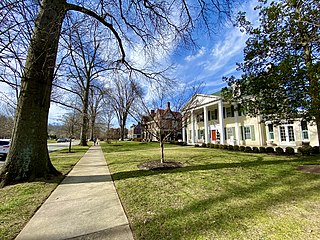
Ritter Park Historic District is a national historic district located at Huntington, Cabell County, West Virginia. The district encompasses 68 contributing buildings and 5 contributing structures, including the Ritter Park municipal park. The city purchased the park property in 1908. Dwellings in the district represent the finest styles in popular architecture from the years 1913 to 1940, including Colonial Revival, Bungalow/craftsman, and Tudor Revival. Notable buildings include the Ritter Park Apartments (1932), Weingartner House, Cammack House (1923), Marshall University President's House (1923), and Park Terrace Apartments.

Monroe Street East Historic District is a national historic district located at Wheeling, Ohio County, West Virginia. The district encompasses six contributing buildings. They are a Greek Revival style church built in 1837, a Roman-Tuscan style dwelling dated to 1852 and known as the Paxton-Reed House, and an eclectic 1881 dwelling. Also in the district is a Richardsonian Romanesque style apartment building and a set of vernacular post-American Civil War townhouses.
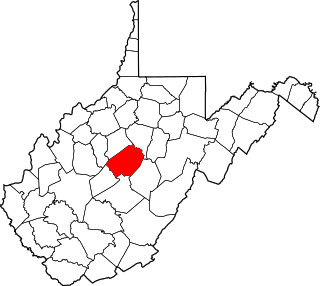
This is a list of the National Register of Historic Places listings in Braxton County, West Virginia.
The West Broad Street Commercial Historic District is a national historic district located at Richmond, Virginia. The district encompasses 20 contributing buildings built between about 1900 and the late 1930s. Located in the district is the Forbes Motor Car Company (1919), Harper-Overland Company building (1921), Firestone Building (1929), Engine Company No. 10 Firehouse, and the Saunders Station Post Office (1937). The majority of the buildings are two-to-four stories in height and are composed of brick with stucco, stone and metal detailing. Located in the district is the separately listed The Coliseum-Duplex Envelope Company Building.
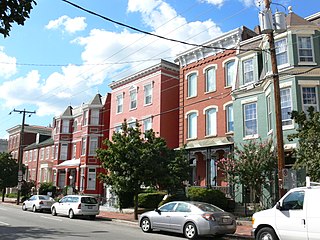
The Block 0-100 East Franklin Street Historic District is a national historic district located at Richmond, Virginia. It is located west of downtown. The district encompasses 21 contributing buildings built between about 1840 and 1920. The district is characterized by numerous mid- to late-19th century brick town houses in a variety of popular 19th-century architectural styles including Queen Anne, Italianate, and Greek Revival.

The Main Street Banking Historic District is a national historic district located in downtown Richmond, Virginia. The district encompasses 19 contributing buildings located south of the Virginia State Capitol and west of the Shockoe Slip Historic District. It is the location of a number of buildings built for or occupied by banking institutions. The district includes representative examples of the Late Victorian and International Style architecture built between about 1865 and 1965. Notable buildings include the Virginia Employment Commission Building (1960), the 700 Building (1964), the Ross Building (1964), the Fidelity Building (1965). Located in the district is the separately listed First National Bank Building.
Huntington Junior College (HJC) is a private for-profit junior college in Huntington, West Virginia. It was founded in 1936 and its campus is currently located in the former Cabell County Public Library building. The college offers six associate degree programs as well as stackable certificates and micro-credentials. It is accredited by the Higher Learning Commission.



















